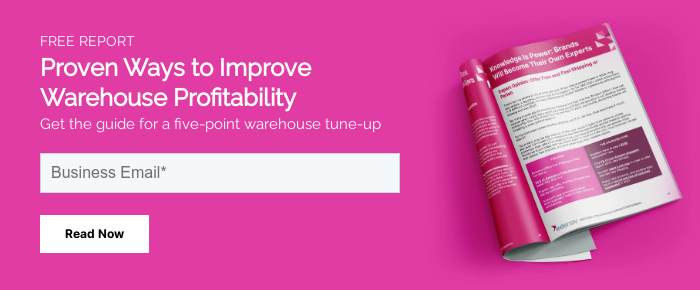Big Data. It’s a term that’s often thrown around when talking about growth and one of the leading buzzwords when talking about the future. But what does it actually mean for warehouses? And more specifically, what does it mean to 3PLs involved in ecommerce operations?
To take a quick step back, Big Data is defined by Gartner as, “high-volume, high-velocity and/or high-variety information assets that demand cost-effective, innovative forms of information processing that enable enhanced insight, decision making, and process automation.”
In other words, Big Data is the culmination of large amounts of information that enable 3PL warehouses to become more efficient by recognizing patterns.
Below, we’ll break down the actual use cases of Big Data in a warehouse, and how it can help 3PLs analyze and grow their ecommerce fulfillment business.
What Does Big Data Do For Ecommerce Warehouses?
Like we noted before, Big Data is all about recognizing patterns to make your ecommerce 3PL more efficient. Examples of this include: internal picking processes, product velocity for seasonal trends, and service/storage fees. We will go through all three use cases below.
Internal Picking Processes
For ecommerce-focused 3PLs, the picking and packing of items to ship can sometimes be a tedious task. Go from aisle 1 to shelf 3 for item x. Then within the same pick order travel all the way to the other end of warehouse to aisle 16 at shelf 5 for product z. The time that it takes to go from one end of the warehouse to the other is valuable time that could made more efficient with Big Data. In noticing that a significant amount of orders seem to contain both products x and z, it stands to reason that these two products should be placed closer to one another. This could shave seconds or even minutes off each pick processed.
While a few seconds here and there might not seem impressive, when considering that thousands of orders are processed each and every day, suddenly the couple seconds turns into hours of labor that can be utilized doing other work. This is then translated to dollars spent on manual labor, and one area of efficiency is optimized.
Increase Product Velocity
Much like order picking, the rate at which products move and how often they are reordered is another insight that can be gleaned from Big Data. When looking at trends both on a micro scale as well as seasonality, Big Data can show both the warehouse and their customers which products are moving quicker, and which would be more advantageous to stockpile in the warehouse in the event of unforeseen peak season. There have been far too many times where an ecommerce business notices trends for specific products all too late. By the time they notice the speed and volume with which the product is moving, they are nearly out of inventory. Now they need to search for last minute suppliers to up their inventory, which could come at a premium and significantly cut their profit margins.
However, if your warehouse had the ability to predict trends and share insights with your customers about their inventory and seasonality before it actually happens, imagine how much time and money you’ll be able to save them. Furthermore, if they are moving more volume to the end consumer, that will likely result in more shipping opportunities, and more revenue driven to your 3PL.
Storage and Service Fees
Different from inventory velocity, warehouses could and should be using Big Data in order to forecast and determine benchmarks for what they can expect to see revenue-wise from specific services (assembly charges for example) of a given customer. Using Big Data, they can then determine the profitability of specific customers, and determine which customer and inventory types are the most profitable given a certain season or situation.
If a warehouse can determine a customer’s fluid profitability, the warehouse could maximize their revenue by managing the most profitable customers and holding the most lucrative inventory.
How To Employ Big Data For Ecommerce 3PL Warehouses?
First, choose which metrics your business is going to track and start collecting data. A good WMS platform will handle many, if not all, warehouse operations, and begin to showcase trends among actions. For each operational action within a warehouse, some number will be assigned to it. From dollar revenue of a product that’s stored, to length of time a product is stored, to length of time taken to be picked, these numbers will help you form trends.
The second thing you’ll need is more of the first. Large sample sizes are crucial in order for Big Data to be statistically significant and actionable. How much data do you need? Depending on the timeframe, metrics you're measuring, and volume of data collected, it can take anywhere from a month's to a year’s worth of data to collect.
Thirdly, choose a partner to analyze the data. Qualtrics, Oracle, and Tableau are great platforms that can digest your large data sets and work on the formulas to determine what actions should be taken. The most important part is finding a partner you can trust. These data analyses can be expensive up front, but when considering how much more you’ll make in the long run, it is an investment that will pay dividends years into the future.
Why Don’t More Ecommerce Warehouses Employ Big Data?
There are loads of reasons why a 3PL warehouse might not use Big Data. Some that we’ve heard include: a lack of time, not knowing how to best review, not understanding the importance of the data, or simply that they’ve always managed without. However, soon none of these reasons are going to hold water if you’re looking to be successful. Your 3PL is going to need to the make the time, learn how it works, and then adapt and implement, if you want to continue to remain competitive with all other warehouses who make the move to utilizing Big Data.
Ecommerce Focused 3PL Big Data Conclusions
To sum things up, yes, you should and need to invest in solutions that can provide insights from Big Data. They can help you optimize your ecommerce warehouse layout, look for profitable products, and retain customers.
If you’re just now finding out about Big Data and are not sure your WMS is up to the challenge, feel free to reach out to a 3PL expert for a personalized consultation. The first step to solving any problem is first recognizing there is one. The second step is asking for help. That’s where we come in. Let us help you take the next step to harness the power of Big Data.








